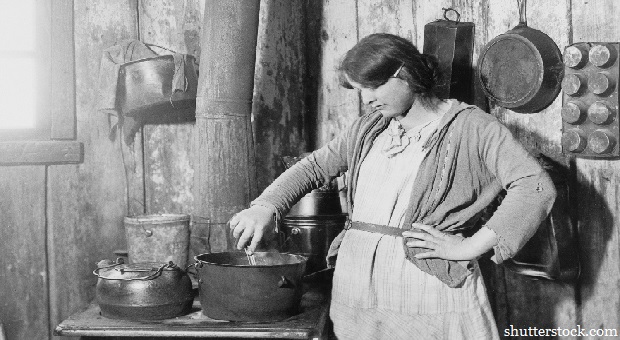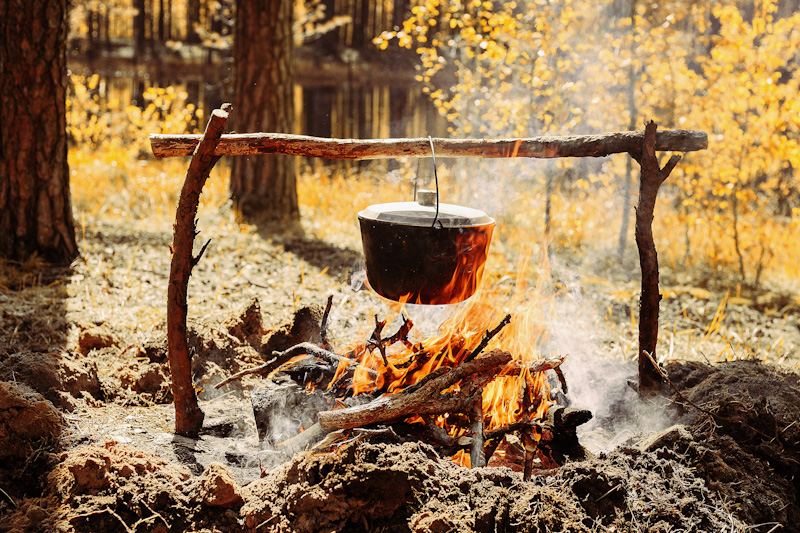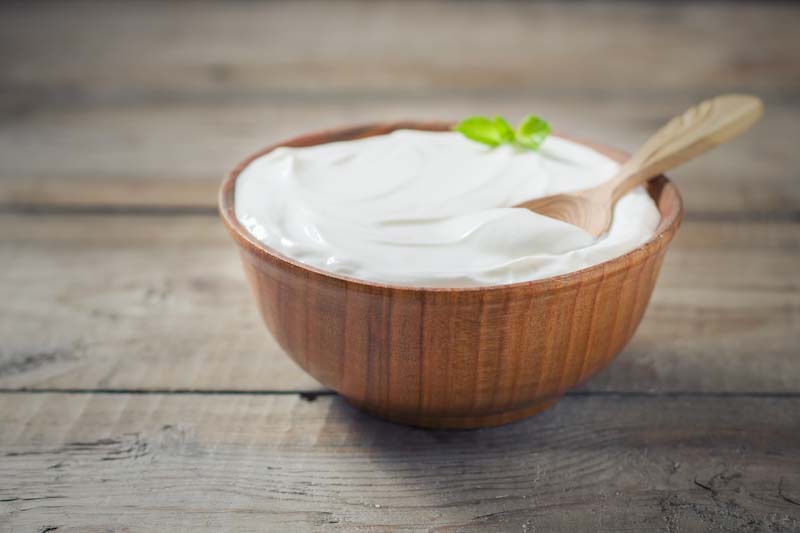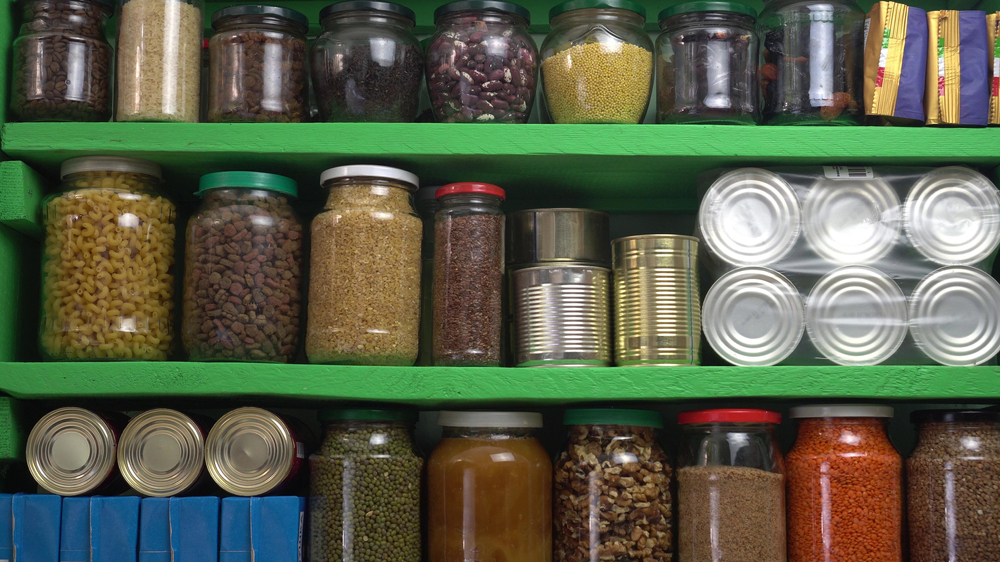As we walk through the air conditioned aisles of today’s grocery stores filled with countless varieties of every type of food imaginable, it’s hard to believe that we live in the same country that – for ten years, between 1929 and 1939 – suffered through the worst economic downturn the industrialized world had ever seen.
But, while life was much harder for survivors of the Great Depression than it is today, any Depression survivor will tell you that (thanks to their innovativeness and ingenuity) they seldom went hungry for any great length of time.
There are a myriad of lessons to draw from survivors of this dark period in American History and practical ways for today’s survivalists to incorporate principles from that time period into everyday living today.
Farming
In the 1930’s, farms were diversified to include a large variety of field crops, garden vegetables and orchard fruit. Small farms also usually included hogs, cattle, chicken and eggs as well as horses and mules for working and often sheep for their wool and their meat.
Many farmers also kept bees in order to harvest the honey. Women baked bread from scratch.
Self-sufficiency meant the difference between life and death, it was both as crucial and as natural as breathing.
This innate sense of self-sufficiency during the Depression spilled over from individual homes into regular social lives. Social circles and churches organized potlucks and “one-dish suppers” as ways to include fun, food sharing and learning.
Radio shows and women’s magazines featured home economists who taught women how to make their food budget stretch with cheap ingredient casseroles and simple toast, waffles and creamed chipped beef recipes. Macaroni and cheese, creamed chicken and biscuits, chili and soups quickly became some of the most popular meals for the time.
Men and women went out rabbit hunting to provide more meat for the dinner table. It wasn’t uncommon to find dead rabbits hanging outside, dressed all the way through so that when it came time to eat one, you would simply cut the string from the rabbit and bring it inside to cook.
All across our great nation, hungry people from all walks of life (especially city dwellers) stood in “soup lines” for one free meal. Life on the farm was spent growing, harvesting, preparing, and then preserving food – activities that filled up most hours of every day.
Without electricity, there was nothing to power refrigerators, so keeping milk and other food fresh was difficult, especially in summer months.
In the days of the Great depression, folks had to learn quickly how to stretch every dollar they had and how to pinch every penny to get as much food as possible during those difficult economic times. The recipes and strategies they came up with may seem strange to us today, but they were featured regularly at dinnertime during the Depression Era.
Here are a few examples:
1. Poor Man’s Meal
Because hot dogs and potatoes were both affordable ingredients during the Great Depression, many meals included one or both of these ingredients. The process of preparing the Poor Man’s Meal included peeling and cubing a potato, frying it in a pan with fat, oil, or butter and chopped onions until browned and softened; then adding slices of hot dogs, cooking a few minutes more, and serving.
2. Creamed Chipped Beef
A simple and cheap dish originally created in Eastern Pennsylvania Dutch Country, the Mid-Atlantic, and New Jersey, Creamed Chipped Beef was made with dried and salted beef. Start by melting 2 tablespoons of butter over medium heat in a pot and adding 2 tablespoons of flour for a roux.
Then, slowly whisk in 1 ½ cups of milk until the mixture begins to thicken and boil. To that, add about 8 ounces of dried beef (i.e. Hormel). Serve the finished product over toast. Fun Fact: Creamed Chipped Beef was affectionately also known as “S.O.S. (or Sh*t on a Shingle, or Save our Stomachs).
This meal was a staple of our U.S. troops during both World War I and World War II.
3. Hoover Stew
Hoovervilles were shantytowns that swiftly sprang up during the Great Depression and were named for our 31st president, who had the dim misfortune of being elected just before the Crash. These towns weren’t the only thing that lent their name to the sitting Commander in Chief, however.
The name was also given to soup kitchen soups or similarly thin broth soup. Hoover stew had many individual variations, but one common recipe began with cooking a 16oz box of pasta noodles (i.e. spaghetti or macaroni). While the noodles were on the stove, hot dogs were sliced into round shapes.
The pasta was drained when it’s nearly done (al dente) and returned to the pot. The hot dogs were then added, along with two cans of whole stewed tomatoes, and one can of corn or peas (undrained). This mixture was then brought to a boil and left to simmer until the pasta was done cooking.
Corn and peas were not required to make the dish correctly, any inexpensive, canned vegetable worked as a sufficient substitute.
4. Egg Drop Soup
Basically a simplified version of a Chinese restaurant favorite, eggs served as a fantastic source of protein, especially in a time when budgets didn’t allow for meat. The easiest way to prepare this soup is to peel and dice both a potato and an onion.
Slowly brown these in a pot with your choice of oil until they are soft. Add bay leaves, salt, and pepper. Once these ingredients are browned, pour in another half pot of water to the mixture to create a broth. Simmer these ingredients on the stove, adding salt and pepper to taste as the potatoes are cooked thoroughly.
While the mixture boils, crack two eggs into the boiling liquid and stir until the eggs are scrambled. Then, add two additional eggs so their yolk hardens. Add cheese to finish it off. Serve alone, or over toast.
5. Corned Beef Luncheon Salad
Gelatin was considered a cutting edge, modern food in the 1930s. This salad recipe was made using canned corned beef, canned peas, lemon juice, vinegar, cabbage and plain gelatin. The recipe was quite popular and remarkably inexpensive to make.
Described by today’s food critics as “wrong in every possible way” when compared with today’s tastes and palates, this meal was actually very popular in it’s time, and affordable to make.
6. Frozen Fruit Salad
Made using canned fruit cocktail (or any other canned fruit), honey, egg yolks, and whipping cream, this dish was served during the holidays as a special treat in a time when ingredients for other desserts were simply hard to come by.
7. Spaghetti with Boiled Carrots and White Sauce Casserole
First Lady Eleanor Roosevelt developed and promoted Home Economics classes in schools and colleges during the Depression and recommended this dish as a staple. The recipe called for spaghetti noodles boiled until they’re very soft (about 25 minutes) then mixed with boiled carrots.
Make the white sauce using flour, milk, salt, butter, and a little pepper. Pour mixture into a tray or dish and bake to make a casserole.
8. Prune Pudding
Although his taste was for much more upscale meals, President Franklin Delano Roosevelt ate modestly in “an act of culinary solidarity with the people who were suffering,” says Jane Ziegelman, to The New York Times. His humble 7 ½ cent lunch included mashed potatoes, coffee, deviled eggs in tomato sauce, and for dessert, prune pudding.
While these recipes may not appeal to today’s tastes and palates, these were actual examples of recipes that got the vast majority of Americans through one of the darkest periods in American History.
Today, were we to be faced with a severe economic collapse, extended grid-down crisis, or other disaster, feeding our families (in principle) will be very similar to how it was done during the Great Depression.
Many great food conservation lessons existed then that exist now. They include knowledge of:
● How to grow, harvest and prepare your own food from your own land
● Sharing with and bartering with your neighbors
● Making the most of what you have on hand
● Thrifty living – reusing and recycling everything you possibly can
● Foraging, hunting, canning, and preserving food
Preppers know that disasters like these occur at any moment and without warning. Being fully prepared ahead of time is the absolute only way to survive comfortably until the disaster has passed. It may very well be a reality that everyone will have to revert to some of the methods our ancestors used to feed their families.
To stay ready, buy and properly store large quantities of rice, flour, beans, cornmeal, sugar, sea salt, and potatoes. Grow, dry, and store your own herbs for seasoning and for use in essential healing oils. In times of severe economic collapse, eggs, raw milk, butter, cream, bacon, pork and beef will all be at a premium or only available through bartering, if available at all.
Raising your own dairy cows, chickens, pigs or beef cows will keep you miles ahead of the game, otherwise you’ll need to own something valuable and be ready to trade it in order to get what you want from someone who has it.










Michele | April 23, 2018
|
I see in my area most fruit trees have been cut down and we are not allowed to have chickens in this city. Growing a vegetable garden on the front lawn is not allowed. I feel like the government is setting people up for starvation. This is just my observation of course.
Learn to do canning. Find abandoned fruit trees or ask to pick fruit from trees on properties where people just don’t want the fruit.
Beans & rice is a protein.
sweat potato, pumpkin or squash mixed with an equal amount of flour rolled out & fried no butter or oil makes flat bread.
Canned veggies taste better fried.
Coconut oil can be used instead of butter or any oil and is good for the memory, and a moisturizer.
Molasses is a cheap iron supplement.
One can chew on wheat grass and spit out the grass and find nourishment.
Roses can be eaten and many more plants.
Save money on hot water, go to a recreation centre and have a swim. Walk more, ride a bike.
Pay some bills in advance so you don’t get charged the tax!
Heidi Carson | April 23, 2018
|
Everybody says, “buy beans”, but I have yet to see a recipe for how to make them edible. I hate beans, so I’d like to find a really tasty recipe that doesn’t have 100 ingredients that have to be fussed with endlessly. Please, somebody tell me how to make rice and beans!
Ruth | April 26, 2018
|
What I do for canned beans like black ones, pintos and even white beans is add salsa and chopped onion to them with salt and pepper or a dash of
celery salt. I have added corn also to break up the taste.
SAM | May 14, 2018
|
I make mine in an electric pressure cooker. Put in rice, a 1 lb. roll of pork breakfast sausage, and dry beans. Nothing else is required. Set on the BEANS setting.
Can also be made in a crock pot but takes several hours on the HIGH setting. Can use canned beans. Cover beans and rice with water, in crock pot OR pressure cooker.
Megha Baikadi | July 15, 2018
|
I’d think you would at least need water in there… I didn’t think sausage had that much extra moisture. Or was the water assumed?
McKenzie Blue | April 28, 2018
|
With most dried beans you can soak a pound in enough water to cover (about 1 cup more water than bean), add 1/8 tsp baking soda, and boil for a few minutes before leaving them to sit for an hour. Then cook 30-45 minutes until tender, add 1 tsp salt and cook another 15 min. Drain them, but reserve the liquid. Slice onion and 3-5 garlic cloves and cook until clear and golden to light brown, then add spices you like, about 3-4 TBS worth and make sure they smell fragrant before you add beans, water or diced tomatoes. Simmer 15-20 minutes, taste and adjust salt and seasonings. Serve with hot rice.
Farmer Phyl | April 23, 2018
|
Michele, not sure where you live, but take a lesson from a couple in Quebec. The city told them they had 30 days to remove their front yard vegetable garden as city ordinance required 30% of the front yard to be in lawn; and all edible plants had to be located so they couldn’t be seen from the street or sidewalk. This couple got on line and posted their city council’s email addresses and asked gardeners from around the world to send an email supporting their cause. Over 1.4 million emails caused the city’s server to crash repeatedly. The city council changed the ordinance! Gardeners are a large group and when combined with technology they are a force to be reckoned with.
Megha Baikadi | July 15, 2018
|
I look at that phrasing, that “edible plants” “can’t be seen” and think about the number of regular lawn plants, even weeds, that are actually edible… somehow I think they didn’t think that through.
Frank Vazquez | April 24, 2018
|
As a resident of Orlando (Florida – Just to clarify) the weather is great for growing food and raising animals, but it can also be harsh. Bugs, rain, and humidity can ruin everything. I have thought about having a survival garden, but think I would prefer greenhouses or screened in structures with strong roofs to protect crops from hard downpours during the rainy season, storms and strong wind during hurricane season. Screening or plastic will protect the plants from frost and insects not to mention the squirrels, birds and other critters that visit or live in our yard, which is around 3.5 acres.
I am near a big college, several community colleges and shopping centers surrounded by neighborhoods from quiet country to typical suburban and even more modern apartment or condo units. It’s actually a nice place to be and there is a pond on our property, another one on the side and one down the street (We lived there for a year) at another house. Ours is more accessible, but at least not the only one. And if needed we can fortify the front and block off the driveway and even partially hide or camouflage some of our resources with fast growing trees.
I just wish I had prepping or survivalist friends to share ideas and maybe even form a group if things go to hell. And since food is the first thing people will be desperate for, it’s wise to raise as much as possible. And so having people involved and helping now would mean less people begging or wanting to get involved, but requiring be carried for a long time until they develop skills and know what their doing. Even having the ability to learn from an article like this, to know how to process food, preserve it and/or create cheap meals would put people further ahead and make them more useful to others and more capable of surviving. They can always learn more, but we all need to learn a few things and have supplies at the onset of a crisis.
Nice article. Would like for you to cover more related subjects. I can see sharing this with others who refuse to prepare. Maybe if they see it’s not that hard or expensive they might adopt a few techniques, skills and or methods that will help them.
Chrissy | April 29, 2018
|
Husband and I tried the Poor Man’s Meal just for fun and OMG YUM! Going to be on regular rotation even though we arnt technically poor.
Kat | August 27, 2023
|
I live in S. Alberta, and while not that regular, we have a few people who have gardens in their front yard. Either the town doesn’t care or doesn’t enforce bylaws, but they are there.
EVERYTHING grows here, including grapes. Probably pineapples, But I suggest a greenhouse for that (which we have in spades: greenhouses, not pineapples) The upshot is that we have gardens . . . EVERWHERE.
I could say it was Covid, but they were there before.
We’re weird.
And that’s okay.